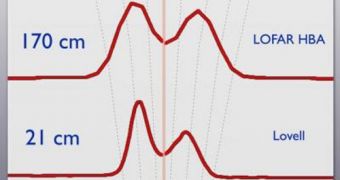An international collaboration of telescopes recently managed to catch an amazing view of how pulsars shine, when it captured images from six such neutron stars at the same time. The investigation was led across a wide range of wavelengths, from 3.5 centimeter to 7 meters, which represents a difference factor of more than 200. This information will be used by astronomers and astrophysicists to gain new insight into how pulsars – peculiar stellar remnants that resemble cosmic lighthouses – shine.
For the study, data from the new European LOw Frequency ARray for radio astronomy (LOFAR) telescope were combined with readings collected by the 100-meter Effelsberg telescope, in Germany, and the 76-meter Lovell observatory, in the United Kingdom. The team that conducted the investigation also included German researchers from the Max Planck Institute for Radio Astronomy, in Bonn. The LOFAR telescope is a unique instrument, featuring detectors centered near Exloo, in the Netherlands, but also extending for hundreds of kilometers into France, Germany, Sweden, and the UK.
Though only about 20 kilometers in diameter, pulsars are generally more massive than our Sun. They are basically fast-spinning neutron stars that produce powerful beams of radio light from their poles. If they are oriented properly in regards to Earth, they become visible across many wavelengths, and – due to their rotation – appear as lighthouses in the sky, which their signature constantly turning on and off. It is very easy to determine their rotation speed, experts say, and a host of other relevant astronomical data is derived from this as well.
By using the two large telescopes, which resolve pulsars in wavelengths of centimeters, with LOFAR, which can operate in wavelengths of meters, the experts managed to get the most complete picture of the six neutron stars. “For comparison, consider that we have simultaneously observed these pulsars over a range equivalent to all the tones spanned by a piano. By simultaneously observing these pulsars at such a wide range of wavelengths, we can make many snapshots of what the pulsar's emission looks like at a range of heights above the star's magnetic poles,” says ASTRON Netherlands Institute for Radio Astronomy expert Jason Hessels.
“These observations show how LOFAR complements the existing radio telescopes in Europe, like the 100-m Effelsberg telescope, in an almost perfect way,” explains the MPIfR director, Michael Kramer. “We are really excited to have the first international LOFAR station operating here in direct vicinity to the giant 100m Effelsberg radio telescope. The combination of both, large parabolic dishes for the centimetre regime, and new digital technology for the longer wavelengths provides a wealth of new data for our pulsar research programs,” concludes Max Planck expert Kosmas Lazaridis.

 14 DAY TRIAL //
14 DAY TRIAL //